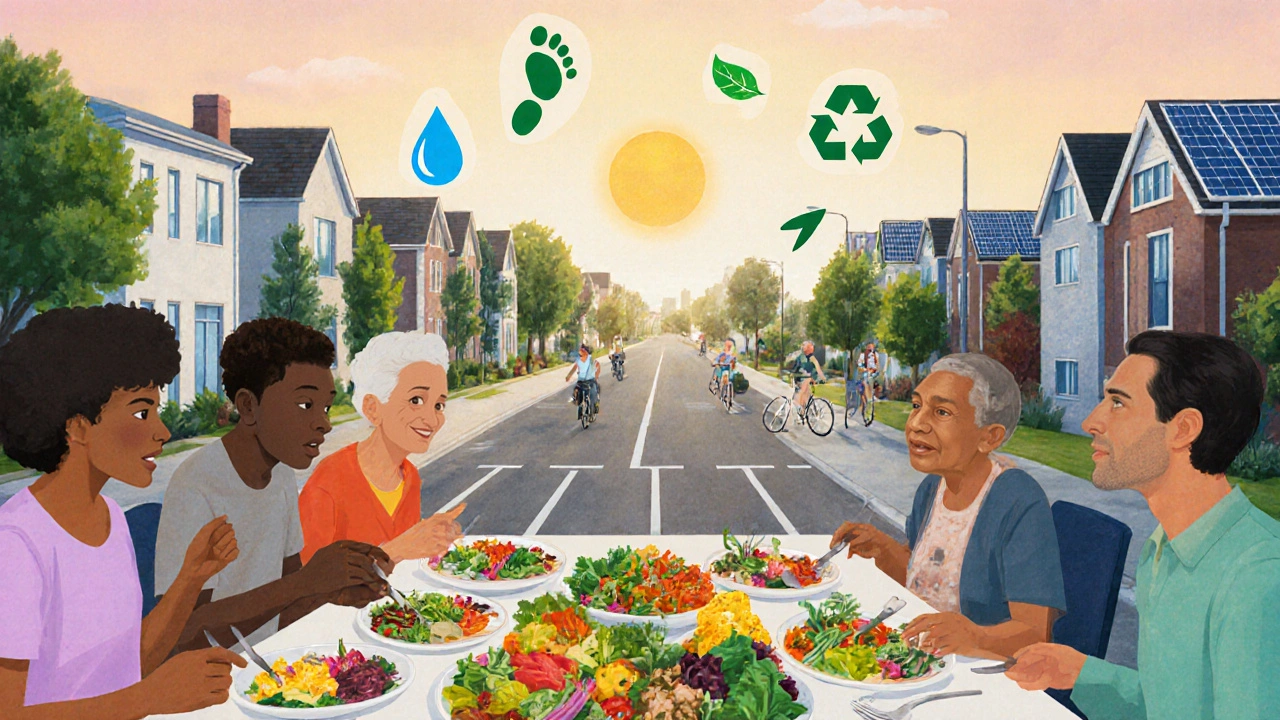Obesity’s Hidden Environmental Cost: How Weight Impacts the Planet

Obesity and Environmental Impact Calculator
Calculate Your Environmental Impact
Enter your BMI and estimated annual food consumption to see how reducing obesity could benefit the environment.
Your Environmental Impact Summary
Based on your inputs, here’s how your lifestyle affects the environment:
- Estimated 0 tCO₂e annual reduction if you reduce your BMI by 2 points
- Potential 0 liters of virtual water saved annually
- Reduction of 0 kg of healthcare waste per year
Key Takeaways
- Obesity adds roughly 0.5%-1% to global greenhouse‑gas emissions each year.
- High‑calorie, animal‑based diets require more land, water and energy than plant‑based alternatives.
- The healthcare system’s energy use and waste generation rise sharply with obesity‑related disease treatment.
- Reducing obesity can cut carbon footprints, ease water stress, and lower waste streams.
- Policy, food‑industry reform, and personal diet shifts are the most effective levers.
When most people think about obesity, the conversation stops at health risks. But there’s a bigger story that rarely makes headlines: the way excess body weight strains the planet. This article unpacks the hidden cost of obesity on the environment, showing how calories, medical care, and waste combine to push climate‑change metrics higher. By the end, you’ll see why tackling obesity isn’t just a personal health goal-it’s also an environmental imperative.
Obesity is a medical condition defined by a body‑mass index (BMI) of 30kg/m² or higher. In 2023, the World Health Organization estimated that 13% of the world’s adult population lives with obesity, a figure that keeps climbing. The sheer number of people affected matters because each extra kilogram of stored body fat represents food that had to be produced, transported, and eventually disposed of.
How Obesity Drives Greenhouse‑Gas Emissions
Every bite of food carries an embedded carbon footprint-from farm to fork. A study by the University of Oxford in 2024 calculated that the average diet of a person with obesity emits about 20% more CO₂e than a diet of someone with a healthy weight. That extra emission comes from three sources:
- Higher caloric intake, often from animal‑based products that are carbon‑intensive.
- Increased food waste due to over‑purchasing and spoilage.
- More frequent medical appointments, surgeries, and pharmaceuticals that require energy‑intensive facilities.
Put together, these factors push the global carbon budget down by an estimated 0.5%-1% each year-a hidden toll that rivals the emissions of small nations like Denmark.
Food Production, Land Use, and the Obesity Connection
Food production is the world’s largest driver of land‑use change, accounting for roughly 30% of global greenhouse‑gas emissions. When diets are high in red meat, dairy, and processed snacks-common in many obesity‑related eating patterns-the land needed for livestock grazing and feed crops expands dramatically.
Consider these figures from the 2023 Global Food Outlook:
- Beef requires about 20m² of land per kilogram of protein, while legumes need just 2m².
- A typical Western diet with high meat consumption uses 1.5times more cropland than a plant‑forward diet.
- Obesity‑related over‑consumption can add an extra 0.3hectares of agricultural land per person annually.
That extra land often comes from deforestation, releasing stored carbon and reducing the planet’s capacity to absorb CO₂.
Water Footprint of Excess Weight
Water usage in agriculture is staggering: producing 1kg of beef consumes roughly 15,000liters of water, compared with 1,250liters for a kilogram of wheat. Since obesity‑linked diets tend toward higher meat and dairy intake, the indirect water demand swells.
Research from the University of Cambridge in 2025 showed that an average obese adult in the UK consumes about 250liters of “virtual water” per day-roughly the same as a small household’s daily water bill. Multiply that across millions of people, and the hidden water stress becomes evident.

Waste Generation and Packaging
Higher caloric intake produces more packaging waste. A 2024 analysis of UK supermarket data linked obesity‑related food purchases to 12% more plastic packaging per household.
Moreover, obesity‑related health care generates additional medical waste. Single‑use syringes, gloves, and disposable linens rise with every surgery or hospital stay. The NHS reports that obesity‑related procedures account for an extra 1millionkg of waste each year, much of it ending up in landfills where it emits methane.
Healthcare System Burden
Healthcare services consume large amounts of energy for heating, cooling, lighting, and operating medical equipment. Treating obesity‑related conditions-type‑2 diabetes, heart disease, certain cancers-means more hospital beds, more imaging scans, and more pharmacy orders.
In the United States, obesity adds an estimated 4% to the total energy use of hospitals, according to the American Hospital Association 2024 report. In the UK, the NHS estimates the carbon cost of obesity‑related care at 2.4milliontCO₂e annually.
Climate Feedback Loops
When obesity drives emissions, land‑use change, and waste, the climate system reacts. Higher temperatures can affect food production, leading to lower yields and more reliance on irrigation-fueling the same cycle of water and energy use.
There’s also a behavioral loop: heat waves increase appetite for high‑calorie foods, while sedentary indoor lifestyles become more common during extreme weather. Breaking this loop requires both dietary shifts and climate mitigation.
Mitigation Strategies: From Plate to Policy
Reducing obesity’s environmental footprint isn’t about a single miracle. It’s a mix of personal choices, industry reform, and public policy.
- Shift to plant‑forward diets: Replacing one weekly beef meal with beans can cut an individual’s carbon footprint by ~2tCO₂e over a year.
- Portion control: Smaller plates and mindful eating reduce excess calories and food waste.
- Food labeling: Carbon‑footprint labels help shoppers pick lower‑impact options.
- Urban planning: More walkable neighborhoods encourage physical activity and reduce car‑related emissions.
- Healthcare incentives: Bundled payments for obesity prevention can lower both medical costs and emissions.
Businesses can also act. A 2025 case study of a UK supermarket chain showed that reformulating popular snack lines to contain 30% less saturated fat reduced the chain’s overall carbon emissions by 1.2% without hurting sales.
Next Steps for Individuals and Communities
Every person can make a measurable difference:
- Track your daily calorie intake and aim for a modest reduction-5% fewer calories can lower your food‑related carbon impact.
- Choose at least two plant‑based meals per week.
- Support restaurants and retailers that offer transparent sustainability information.
- Engage with local councils on creating safe walking and cycling routes.
- Advocate for workplace wellness programs that include nutrition counseling.
Collectively, these steps can turn the hidden cost of obesity into a visible opportunity for climate action.
| Food Type | Carbon Footprint | Typical Serving Size |
|---|---|---|
| Beef (ground) | 27 | 150g |
| Lentils (cooked) | 0.9 | 150g |
| Cheddar cheese | 13.5 | 30g |
| Chicken breast | 6.9 | 150g |
| Apples (raw) | 0.3 | 150g |

Frequently Asked Questions
How much does obesity contribute to global CO₂ emissions?
Research published in 2024 estimates that obesity adds roughly 0.5%-1% to worldwide greenhouse‑gas emissions each year, mainly through higher‑calorie, animal‑heavy diets and increased healthcare activity.
Can switching to a plant‑based diet reduce my obesity‑related carbon footprint?
Yes. Replacing just one weekly beef meal with beans can cut an individual’s carbon emissions by about 2tCO₂e per year, while also lowering calorie intake.
What role does healthcare waste play in the environmental impact of obesity?
Obesity‑related medical procedures generate extra disposable items-gloves, syringes, linens-adding roughly 1millionkg of waste annually in the UK NHS alone, much of which ends up as methane‑producing landfill waste.
How does obesity affect water scarcity?
High‑meat diets require far more irrigation. An obese adult’s typical diet can demand up to 250liters of virtual water each day, contributing to regional water stress, especially in arid producing areas.
What policies can governments adopt to lower obesity’s environmental impact?
Effective measures include carbon‑footprint labeling, subsidies for plant‑based foods, urban design that encourages active transport, and bundled healthcare payments that reward obesity prevention.
Karen Nirupa
October 4, 2025 AT 01:30Thank you for shedding light on a dimension of obesity that often eludes public discourse; the planetary ramifications are as pressing as the personal health concerns. It is noteworthy how the article intertwines dietary patterns with carbon footprints, a nexus that resonates across cultures. By highlighting the disproportionate impact of animal‑based diets, the piece invites a global conversation about sustainable nutrition. Moreover, the emphasis on policy levers and urban planning underscores the need for coordinated action beyond individual willpower. I appreciate the comprehensive approach and hope it spurs interdisciplinary collaboration.
Quinn Comprosky
October 8, 2025 AT 16:37Honestly this article just opened my eyes to how our extra pounds are basically extra carbon emissions feeding the planet more than we ever imagined especially when you think about every piece of meat we overindulge in it's like a hidden tax on the environment that we all pay without even realizing and the way the healthcare system adds to the waste stream with all those disposable syringes gloves and linens just blows my mind because we usually only think about the personal health costs and not the planet's health we need to start seeing obesity as a climate issue too and not just a medical one
Thomas Ruzzano
October 13, 2025 AT 07:43Wow, what a brilliant piece of propaganda trying to guilt‑trip everyone into eating kale while ignoring the freedoms we hold dear! The article reeks of eco‑fanaticism, painting the average American diet as a villainous monster that threatens the planet, when in reality it’s the same old alarmist spiel that tries to control our plates. If you’re going to blame beef for climate change, at least admit that it’s the government subsidies and industrial farming that fuel the problem, not the innocent folks who just love a good burger.
Dan Tenaguillo Gil
October 17, 2025 AT 22:50Let me add a bit of perspective here: the link between excess weight and environmental strain is indeed real, but addressing it requires inclusive solutions rather than shaming. Education about plant‑forward meals and portion control can empower communities without alienating anyone. Also, infrastructure that encourages walking or cycling helps both weight management and emissions reduction. In short, compassionate guidance paired with supportive policies can make a measurable difference.
Tiffany Owen-Ray
October 22, 2025 AT 13:57It's fascinating to contemplate how our bodies and the planet are intertwined; each extra calorie we consume not only burdens our metabolism but also the Earth’s resources. Think of it as a philosophical balance: when we overindulge, we tip the scales of sustainability. By adopting mindful eating habits, we not only improve personal health but also honor the planet’s finite capacities. Let’s view weight management as a shared responsibility, a collective act of stewardship.
Jill Brock
October 27, 2025 AT 05:03Seriously, this article is a melodramatic scream fest about carbs and climate, and it makes me want to scream back! The drama of linking every bacon strip to a melting iceberg is pure theatrics. If you want real change, stop obsessing over numbers and start demanding food companies to stop pushing junk while pretending you’re saving the world one lettuce leaf at a time. Enough with the guilt trips!
Ellie Chung
October 31, 2025 AT 20:10Wow, this piece really paints a vivid tapestry of how our love for greasy delights drags the planet into a greasy mess-just fabulous! The way it connects a double‑cheese pizza to a carbon nightmare is pure literary gold. If only we could sprinkle some kale on that pizza and watch the emissions melt away, right?
Sophia Simone
November 5, 2025 AT 11:17While the article presents a commendably thorough analysis, I must respectfully dissent on the implied causality between individual BMI and macro‑scale emissions. The data, though compelling, may exaggerate the marginal impact of personal dietary excess when juxtaposed against industrial agriculture’s systemic footprint. A more rigorous statistical segmentation would bolster the argument and prevent over‑generalization.
Juan Sarmiento
November 10, 2025 AT 02:23Hey folks, love how this breaks down the hidden costs-makes me want to swap my late‑night snacks for a quick walk. Small steps add up, and together we can tackle both health and the planet. Let’s keep each other motivated, one veggie‑filled meal at a time!
Patrick McVicker
November 14, 2025 AT 17:30Nice article! 👍 Very eye‑opening. I never thought my love for burgers could be linked to water usage. 😮 Definitely going to watch my portions more closely now. Thanks for the info! 😊